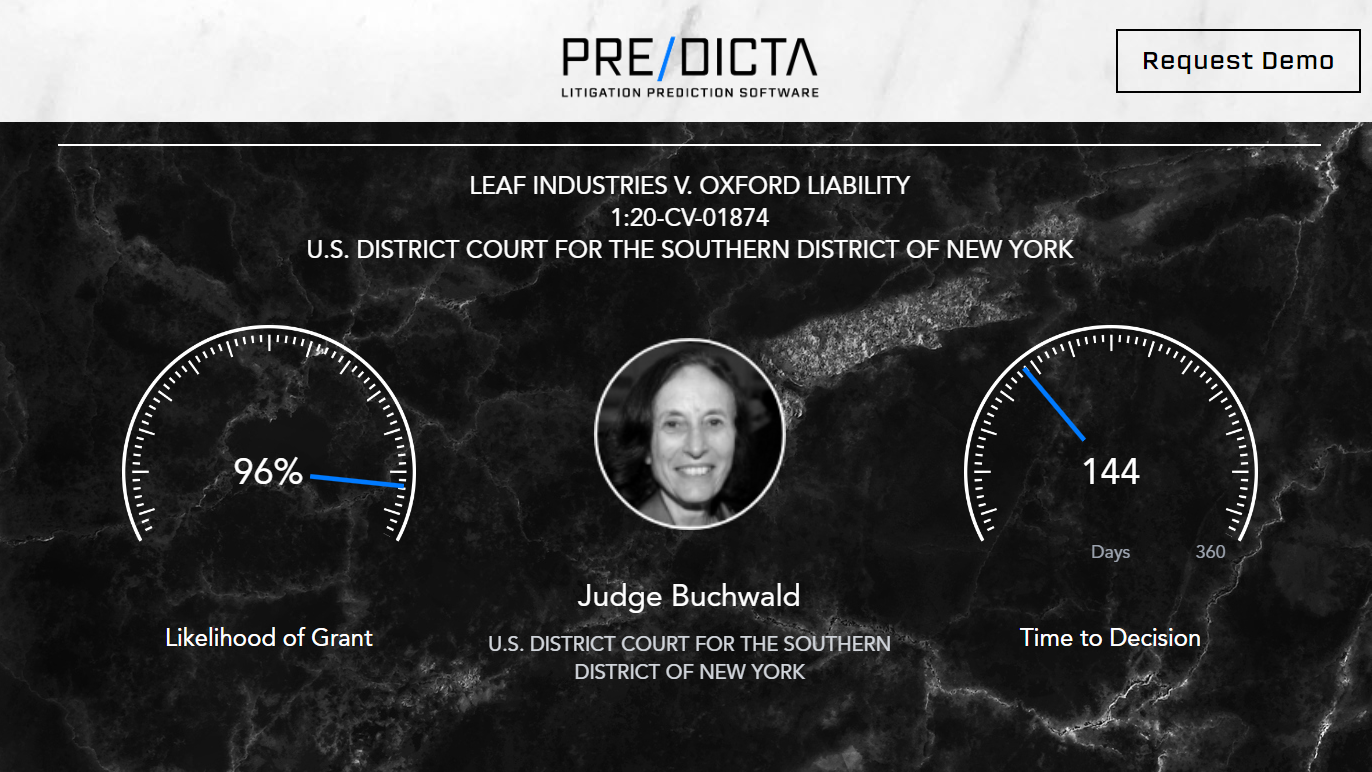I am a big fan of litigation analytics, even once suggesting that it could be malpractice for a litigator not to use the technology.
There are a number of litigation analytics products on the market, and what they all have in common is that they extract data from court dockets and apply analytics to provide insights into how judges rule in particular times of matters.
Analytics might tell you, for example, that, in intellectual property cases, Judge Smith decides summary judgment motions for plaintiffs 70% of the time.
That is useful information, because it provides insights into a judge’s propensities. But it only tells you past behavior. It does not tell you the all-important question: How will Judge Smith rule on your specific motion?
Until now, that has been the golden fleece that has eluded analytics products – predicting how a judge will rule in the specific case at hand.
Now comes a company that claims to do just that – to predict how a judge will rule, and to do so with an accuracy rate of 86.7%.
Likelihood of Winning
Launched last week, Pre/Dicta uses data science to understand the decisional patterns of every federal district judge in every commercial case, which it says enables it to predict with a high degree of accuracy a party’s likelihood of winning or losing.
What distinguishes Pre/Dicta from other litigation analytics products is that its algorithms consider not just docket data, but also a range of available biographical and financial data on federal judges – such as net worth, education, work experience, political affiliation, and more – to uncover hidden patterns in their decision-making.
By factoring in this additional data, Pre/Dicta says it is able to evaluate how other factors in a case may influence the outcome. Is the judge influenced by the prestige of the firm, the law schools of the lawyers, their political affiliations, or the nature of the company? All of these factors play into Pre/Dicta’s predictions, the company says.
As it launches to the market, Pre/Dicta provides predictions only for motions to dismiss in federal court. But it plans to expand to cover other types of motions, such as summary judgment, and to include state courts, with California, New York and Texas already in development.
“We’re proud to release the only platform that makes concrete predictions about federal cases, and the only platform to focus on the judge and the personal factors that play a role in how they decide cases,” said Pre/Dicta cofounder and CEO Dan Rabinowitz.
Rabinowitz is a lawyer who practiced as an associate in Sidley LLP’s Supreme Court & Appellate and Mass Tort Litigation groups. Later, he served as a trial attorney for the U.S. Department of Justice; the general counsel to a Washington, D.C. data science company; and associate general counsel, chief privacy officer, and director of fraud analytics for WellPoint Military Care.
His cofounder, and the company’s chairman, is Louis Mayberg, currently the CEO of CyLogic Inc., a cybersecurity, cloud computing infrastructure and end-point protection provider. Mayberg is a co-founder and principal of ProShares and ProFunds, exchange-traded funds and mutual funds, where he served as president.
‘The Essence Of A Judge’
In a demonstration of Pre/Dicta last week, Rabinowitz told me that his goal with the product was to use legal analytics in a fundamentally different way than anyone has up to now.
While there have been many innovative analytics products, he said, the problem is that they all fail to account for the person who makes the ultimate decision – their personalities and the influences that they bring to their decision making.
Put the same issue before five different judges, and you are likely to get five different opinions, he said, and those differences are attributable not to differences in their knowledge of the law, but to their own personalities and the influences they bring to the case.
“We went beyond the opinions and try to understand who each individual judge is,” he said. “We try to get to the essence of who a judge is.”
To do this, Pre/Dicta incorporates data on non-docket factors such as a judge’s law school, net worth, biography and demographic data.
(Rabinowitz said that Pre/Dicta analyzes dozens of data points, but he declined to reveal the full list of factors.)
While other platforms may tell you that a judge has denied motions to dismiss in 99% of securities cases, they do not tell you what was going on in the 1% of motions the judge granted.
“Maybe that 1% is driven by BigLaw attorneys opposing small plaintiffs where the judge sees them as rapacious and mercenary,” Rabinowitz said.
Even though it may be that, for certain data points, Pre/Dicta has little or no data on a judge, Rabinowitz said that it looks at so many data points overall that its predictions are still highly accurate.
I asked, for example, about a judge who is new to the bench, who perhaps has decided only a couple of motions to dismiss.
In that case, Rabinowitz said, Pre/Dicta is able to align that judge with all the other data points and find patterns that match similar judges and still make a prediction.
“If you think about what we’ve done, we’ve created a massive spreadsheet, and that’s just one column, but we can still match up all the other patterns that we have and find similar judges.”
For brand new judges, the accuracy rate of 86.7% drops by only three points, he said. “That is still beyond the capability of any attorney to accurately predict what Judge Johnson is going to rule on their motion.”
How Pre/Dicta Works
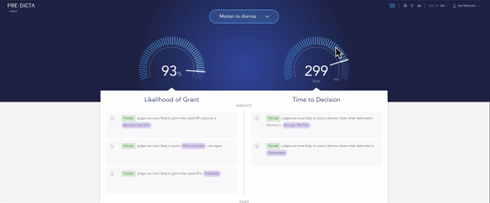
The software predicts the likelihood a motion will be granted and the time to decision.
Using Pre/Dicta is a snap. Simply enter a PACER case number and the software pulls up information on the case, showing the nature of suit, parties, court and judge. From there, click “Motion Prediction” and the software displays two results: percentage likelihood of grant (such as 93%) and time to decision (such as 299 days).
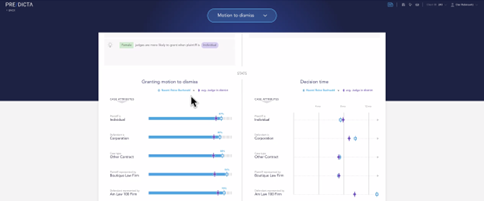
Pre/Dicta also displays some of the factors that went into the prediction.
It also displays some of the factors it used to make the prediction. In a case Rabinowitz demonstrated, it predicted a high likelihood of grant, suggesting, “Female judges are more likely to grant when plaintiff’s attorney is Boutique Law Firm.” As for timing, it offered, “Female judges are more likely to reach a decision faster when defendant is Corporation.”
The software also breaks down likely outcomes based on specific case attributes. In the example Rabinowitz showed me, I could see the impact of factors such as that the defendant is a corporation or that it is represented by an Am Law 100 law firm.
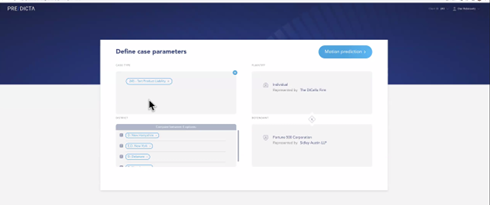
For a case that has not been filed, Pre/Dicta predict likely outcomes in multiple jurisdictions.
Pre/Dicta can also be used to assess cases that have yet to be filed. This can be useful, for example, when a plaintiff has options for filing a case in different jurisdictions and is trying to determine which is more favorable.
For unfiled cases, rather than enter a case number, the lawyer would enter available information about the case, such as the nature of the suit, the types and names of parties, and the names of the attorneys for each party, as well as the potential jurisdictions.
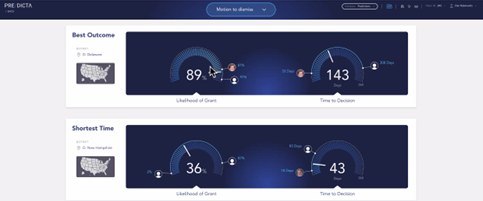
It tells you the courts where you will likely get the best outcome or the shortest time to decision.
With that information, Pre/Dicta generates a comparison of the jurisdictions and a recommendation as to the one that will result in the best outcome or the shortest decision time. The user can also click to see predictive information for each judge in each jurisdiction.
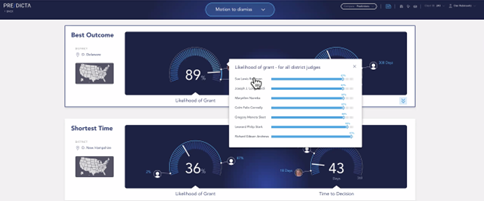
It can also provide predictive information for each judge within a jurisdiction.
Rabinowitz declined to provide specific information on how the product is priced, other than to say that it is a monthly subscription that allows a set number of searches per year. But he said the pricing is reflective of the value delivered, especially when considering that an accurate prediction could have an impact on a client of millions of dollars.
The bottom line, says Rabinowitz, is that no matter how hard an attorney works on a case, no matter how skillfully the lawyer represents the client, their success is still subject to how the judge will rule.
“That has been a total black box up to this point, despite the efforts that attorneys put in, they have no ability to understand that – they’re working in the dark. This enables them, by looking at the judge, to have a better sense and make strategic decisions based on data and have confidence in them.”
 Robert Ambrogi Blog
Robert Ambrogi Blog